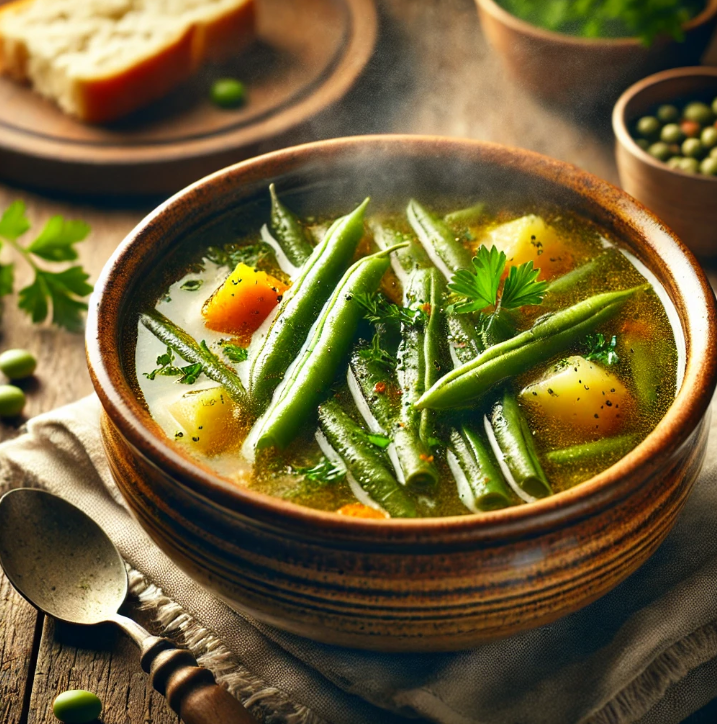There’s something incredibly comforting about a warm bowl of green bean soup. Whether it’s a creamy variation, a traditional Asian mung bean-inspired version, or a quick puree soup, this dish is as versatile as it is delicious. Green bean soup has stood the test of time, gracing tables across the world with its unique blend of simplicity and nutrition.
In this guide, we’ll dive into what makes green bean soup so special. We’ll explore its origins, health benefits, popular recipes, and cooking techniques, plus offer creative variations to suit any dietary preference. Whether you’re a seasoned home cook or just getting started in the kitchen, there’s a green bean soup recipe for everyone.
Table of Contents
What Is Green Bean Soup?
An Overview of Green Bean Soup
Green bean soup is a hearty and nourishing dish that can be found in a variety of cuisines. It typically combines fresh or frozen green beans with a flavorful broth, creating a light yet satisfying meal. Some versions are creamy and indulgent, while others focus on fresh, natural flavors.
One of the reasons this soup is so popular is its versatility. It can be made vegan, vegetarian, or protein-packed, depending on your preferences. Whether served as an appetizer or a main course, it is a staple for its ease of preparation and ability to adapt to different tastes.
Historical Roots and Popularity Across Cultures
The history of it spans across continents, with each culture adding its own spin. In Europe, creamy green bean soups are a favorite, often paired with potatoes or bacon for extra flavor. In Asia, green bean soup is commonly made with mung beans and sweetened for a refreshing dessert.
No matter the preparation, the dish remains a symbol of comfort and tradition. Its popularity continues to grow, especially among those seeking healthier meal options or quick weeknight recipes.
Nutritional Benefits
Key Vitamins and Minerals Found in Green Beans
Green beans are a treasure trove of nutrients, making them the perfect star ingredient for a healthy soup. Packed with vitamins A, C, and K, green beans support immune health, bone strength, and skin vitality. They’re also loaded with folate, an essential nutrient for cell growth and repair.
In addition to vitamins, green beans provide vital minerals like potassium, magnesium, and iron. These minerals help regulate blood pressure, improve energy levels, and maintain overall well-being. Incorporating it into your diet is an easy and delicious way to boost your intake of these essential nutrients.
Low-Calorie and High-Fiber Health Benefits
If you’re looking for a low-calorie yet filling dish, it is the answer. Green beans are naturally low in calories, making them a guilt-free choice for anyone aiming to maintain or lose weight. Plus, they’re a great source of dietary fiber, which supports digestion and helps you feel full longer.
Fiber also promotes healthy cholesterol levels and keeps blood sugar stable, making this soup an excellent option for individuals managing diabetes or heart health. Pair it with lean proteins or whole grains for a complete, balanced meal.
Why It Is Great for Digestion
One standout benefit of it is its positive impact on digestion. The high fiber content in green beans not only aids regular bowel movements but also feeds beneficial gut bacteria, supporting a healthy microbiome.
Additionally, the broth in many green bean soup recipes provides hydration and electrolytes, which are essential for digestive health. This combination of fiber and hydration makes it a gentle, soothing choice for your digestive system.
Types of Green Bean Soup Recipes
Classic Creamy Green Bean Soup
For a rich and satisfying meal, creamy green bean soup is a classic choice. This version typically includes green beans, potatoes, onions, and a creamy base made with heavy cream or coconut milk. To enhance the flavor, add garlic, thyme, or even a splash of white wine.
The result is a velvety soup that’s perfect for a cozy dinner. Garnish with crispy bacon bits or a sprinkle of fresh parsley to elevate this dish even further. Pair it with a slice of crusty bread for a comforting meal.
Traditional Asian Mung Bean Soup with Green Beans
In many Asian countries, mung bean soup is a beloved recipe that often features green beans for added texture and nutrition. This version is typically sweetened with rock sugar and flavored with pandan leaves, creating a refreshing dessert soup.
For a savory twist, some recipes combine mung beans, green beans, and ginger in a light broth. This variation is not only delicious but also packed with health benefits, as ginger aids digestion and provides anti-inflammatory properties.
Quick and Easy Green Bean Puree Soup
If you’re short on time, a green bean puree soup is a quick and simple option. Blend cooked green beans with vegetable or chicken broth, garlic, and a touch of cream for a smooth, velvety texture.
This soup can be seasoned to your liking—add nutmeg for a warm, earthy flavor or lemon juice for a bright, tangy finish. It’s an ideal recipe for busy weeknights or as a light appetizer before a larger meal.
Cooking Techniques for Perfect Green Bean Soup
How to Choose Fresh and Flavorful Green Beans
The success of any green bean soup recipe starts with choosing the right green beans. Look for beans that are bright green, firm, and free from blemishes. Fresh green beans snap easily when bent, making them ideal for soups that require a slight crunch or tender texture.
If fresh green beans aren’t available, high-quality frozen beans are a great alternative. They’re picked and frozen at peak ripeness, preserving their flavor and nutrients. When using frozen beans, avoid thawing them completely before adding them to the soup to retain their texture.
Tips for Achieving the Perfect Texture
The texture of green bean soup can vary based on the recipe, but achieving the right balance is key. For creamy soups, cook the beans until soft and then blend them into a smooth consistency using a hand blender or food processor. Add cream or a plant-based alternative for extra richness.
For broth-based soups, aim for green beans that are tender yet slightly crisp. Blanching the beans before adding them to the soup helps maintain their vibrant color and prevents overcooking during simmering.
Balancing Flavors with Herbs and Spices
To enhance the natural flavor of green beans, consider adding complementary herbs and spices. Garlic, thyme, and bay leaves work well in savory recipes, while ginger and lemongrass add a unique twist to Asian-inspired soups.
Don’t forget to taste and adjust as you go. A pinch of salt or a splash of lemon juice can bring out the best in a green bean soup, creating a dish that’s both flavorful and memorable.
Variations and Add-Ons for Green Bean Soup
Adding Proteins Like Chicken or Bacon for a Hearty Dish
For a more filling version of green bean soup, consider adding proteins like shredded chicken, diced ham, or crispy bacon bits. These ingredients not only enhance the flavor but also make the soup a complete meal.
To incorporate chicken, simply shred cooked chicken breast or use leftover rotisserie chicken. For bacon lovers, crisp up some bacon slices and crumble them over the soup just before serving for an irresistible smoky touch.
Vegan and Gluten-Free Green Bean Soup Options
Creating vegan and gluten-free variations of green bean soup is easy and delicious. Use vegetable broth as the base, and replace cream with coconut milk or blended cashews for a creamy texture. Add hearty vegetables like potatoes, carrots, or lentils for extra nutrients and substance.
For gluten-free options, ensure any thickeners used, such as cornstarch or arrowroot powder, are free of wheat-based additives. This ensures your soup caters to a wide range of dietary preferences without compromising on flavor.
Seasonal Ingredients to Enhance the Flavor
Seasonal produce can take your green bean soup to the next level. In summer, add fresh tomatoes or zucchini for a light and refreshing twist. In fall or winter, incorporate root vegetables like parsnips or sweet potatoes for a comforting, hearty meal.
Herbs like basil, parsley, or dill can be used as garnishes, adding a burst of freshness to the soup just before serving. Experimenting with seasonal ingredients keeps your recipe exciting and flavorful year-round.
For more delicious recipes featuring green beans, check out the Green Beans Crock Pot Recipe on Recipes to Explore. It’s a fantastic side dish to pair with your soup!
Frequently Asked Questions About Green Bean Soup
Can You Make Green Bean Soup Ahead of Time?
Yes, green bean soup is an excellent dish to prepare in advance. In fact, making it ahead of time often enhances the flavors, as the ingredients have more time to meld together. Once cooked, let the soup cool completely before storing it in an airtight container in the refrigerator. It will stay fresh for up to 3–4 days.
If you’re planning to freeze the soup, use freezer-safe containers and leave some space at the top to allow for expansion. For best results, avoid adding dairy, such as cream, until reheating, as it can separate when frozen.
How Long Does Green Bean Soup Last?
When stored properly, green bean soup can last in the refrigerator for up to 4 days. Always reheat the soup on the stovetop or in the microwave, stirring occasionally to ensure even heating. If you’ve added meat or dairy, consume it within 2–3 days to maintain freshness.
For longer storage, freezing is the way to go. Frozen green bean soup can last up to 3 months. To reheat, thaw it overnight in the fridge and warm it gently over low heat to preserve its flavor and texture.
What Side Dishes Pair Well with Green Bean Soup?
Green bean soup pairs wonderfully with a variety of side dishes. A slice of crusty bread or garlic toast complements the soup’s texture and makes for a satisfying meal. For a lighter option, serve it with a fresh green salad or roasted vegetables.
If you’re looking to add more protein, consider pairing the soup with a grilled chicken breast, salmon fillet, or even a hard-boiled egg. These additions turn the soup into a hearty, well-rounded dish that’s perfect for lunch or dinner.
For more green bean recipes, don’t miss this creative sausage broccoli stir-fry—a perfect side or main dish.
FAQs from Google’s People Also Ask Section
Is Green Bean Soup Healthy?
Yes, green bean soup is incredibly healthy! It’s packed with nutrients like vitamins A, C, and K, which are essential for boosting immunity, promoting good vision, and maintaining strong bones. The high fiber content in green beans also aids digestion and helps regulate blood sugar levels.
When prepared with light broths and minimal fats, green bean soup becomes a low-calorie, nutrient-dense meal that fits perfectly into most diets. By using fresh ingredients and skipping processed additives, you can ensure the dish is both healthy and delicious.
How Do You Thicken Green Bean Soup?
There are several ways to thicken green bean soup depending on the desired texture. For creamy soups, blend a portion of the soup and stir it back in for a velvety consistency. Adding potatoes or carrots during cooking can also naturally thicken the broth when pureed.
Alternatively, you can use a roux made from flour and butter or mix cornstarch with a bit of cold water before adding it to the soup. Both methods are quick and effective for creating a thicker, heartier dish.
Can You Freeze Green Bean Soup?
Absolutely! Green bean soup freezes very well, making it an ideal option for meal prep. Before freezing, let the soup cool completely and portion it into airtight freezer-safe containers. Label each container with the date for easy tracking.
When reheating frozen soup, avoid boiling it too vigorously, as this can affect the texture of the green beans. Instead, warm it gently over medium heat, stirring occasionally, until it’s heated through.
If you’re exploring more comforting soups, try this delicious easy wor wonton soup recipe.
The Cultural and Nutritional Significance of Green Bean Soup
Green Bean Soup Across Cultures
Green bean soup has a rich history in global cuisines, reflecting diverse cooking styles and cultural preferences. In European traditions, it’s often made creamy with milk or cream, accompanied by hearty ingredients like potatoes or smoked meats. This version is popular for its comforting and satisfying qualities, especially during colder months.
In contrast, Asian cultures have their own unique take on green bean soup. In Chinese cuisine, mung bean soup is a variation often served as a dessert, combining green beans with rock sugar and coconut milk for a sweet, refreshing treat. In Southeast Asia, green bean soups are spiced with ingredients like ginger, lemongrass, or chilies to create vibrant, flavorful dishes.
The versatility of green bean soup allows it to fit seamlessly into any culinary tradition, making it a universally loved dish.
Why Green Bean Soup Is a Nutritional Powerhouse
From a health perspective, green bean soup is an excellent choice for anyone looking to add more nutrients to their diet. Green beans are low in calories but high in essential vitamins, including A, C, and K. They’re also a great source of iron, magnesium, and folate, which support overall health.
Adding ingredients like garlic, onions, and olive oil enhances the soup’s nutritional profile, providing anti-inflammatory and heart-healthy benefits. Whether you’re following a plant-based diet or just trying to eat healthier, green bean soup is a delicious way to nourish your body.
For a complementary side dish, try this French-style green beans recipe for a light and flavorful pairing.
Final Thoughts and Tips for Enjoying It
Why It Deserves a Place in Your Recipe Rotation
It isn’t just a meal—it’s a versatile, nutritious, and comforting dish that works for every occasion. Its adaptability makes it suitable for quick weekday dinners, elegant dinner parties, or meal prep for busy weeks. Plus, with so many variations to try, you can keep your recipe fresh and exciting every time.
Whether you prefer creamy soups, chunky broths, or a lighter, Asian-inspired version, It can easily become a go-to option in your kitchen. Its balance of flavor, texture, and nutrition makes it a standout dish worth adding to your repertoire.
Tips for Making Green Bean Soup Your Own
The beauty of it lies in its flexibility. Experiment with different seasonings, broths, and toppings to create a version that suits your taste. Try adding roasted garlic for depth, a dash of lemon juice for brightness, or a sprinkle of Parmesan cheese for a savory finish.
If you’re feeling adventurous, explore cultural variations by incorporating ingredients like coconut milk, ginger, or smoked paprika. With endless possibilities, you’ll never run out of ways to enjoy this timeless dish.
For more creative variations and tips on making green bean soup, check out Tasty. Their collection of recipes offers exciting ways to elevate this classic dish with bold flavors and unique ingredients!



3 thoughts on “The Ultimate Guide to Green Bean Soup: Recipes, Tips, and Nutritional Benefits”